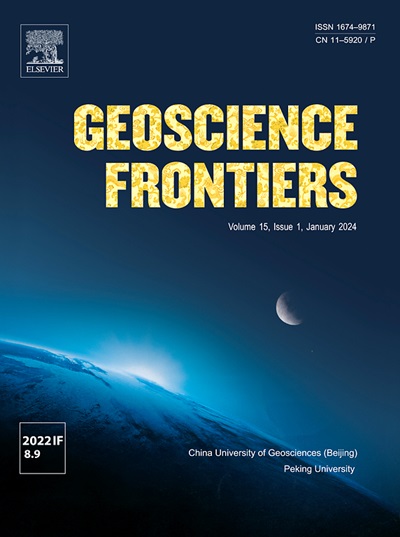海南岛热带花岗质风化层产量的定量研究:多阶段u系列不平衡研究
IF 8.9
1区 地球科学
Q1 GEOSCIENCES, MULTIDISCIPLINARY
引用次数: 0
摘要
沉积岩广泛分布于地球表面,是临界区的重要组成部分,是大气圈、岩石圈、水圈和生物圈之间错综复杂的相互作用的结果。岩石的形成对养分释放、土壤生产和长期气候调节有着至关重要的影响。岩石的形成受两个主要过程的制约:生成和剥蚀。我们迫切需要全面了解这些过程,以完善对临界区功能的认识。本研究调查了热带地区(中国三亚)花岗岩基岩上发育的原地碎屑岩剖面。我们进行了地球化学分析,包括主要元素、微量元素和矿物成分以及铀系列同位素,并应用铀系列不平衡法研究了该剖面的形成历史。另外,将碎屑岩剖面划分为亚风化带也能更好地解释地球化学结果,基于这种划分的多阶段模型能有效解释深层碎屑岩的演化过程。利用这种多阶段模型,可以从 "增益和损耗 "模型中推导出沉积岩的产出率,范围从 1.27 ± 0.03 到 42.42 ± 24.24 m/Ma。生产率首先从地表开始上升,直到 160 厘米深度达到最大生产率,然后沿深度剖面在更深的地层下降,生产率的变化遵循所谓的 "驼峰函数"。这项对中国热带地区沉积物产出率的开创性研究表明:(1)与宇宙成因核素(10Be_原位)得出的剥蚀率相比,所研究的剖面偏离了稳定状态;(2) 根据地球化学数据和铀系列同位素活度比对深部剖面进行细分,是准确确定碎屑岩产出率的必要条件;(3) 将铀系列不平衡和宇宙成因核素结合起来,可以有力地评估碎屑岩在长时间尺度上的定量演化状态。本文章由计算机程序翻译,如有差异,请以英文原文为准。

Quantifying production rates of tropical granitic regolith in Hainan Island, south China: A multi-stage U-series disequilibrium study
Regolith, widely distributed on the Earth’s surface, constitutes a significant compartment of the Critical Zone, resulting from intricate interactions among the atmosphere, lithosphere, hydrosphere, and biosphere. Regolith formation critically influences nutrient release, soil production, and long-term climate regulation. Regolith development is governed by two primary processes: production and denudation. An urgent need exists to comprehensively understand these processes to refine our understanding of Critical Zone functions. This study investigates an in-situ regolith profile developed on granitic bedrock from a tropical region (Sanya, China). We conducted geochemical analyses, encompassing major, trace elements and mineralogical compositions as well as U-series isotopes, and applied the U-series disequilibrium method to investigate the formation history of this profile. Alternatively, dividing the regolith profile into sub-weathering zones provides a better explanation for the geochemical results, and a multi-stage model based on this subdivision effectively interprets the evolution of deep regolith. Utilizing this multi-stage model, regolith production rates is derived from the “gain and loss” model, ranging from 1.27 ± 0.03 to 42.42 ± 24.24 m/Ma. The production rates first increase from surface until a maximum rate is reached at the depth of ∼ 160 cm and then decrease at further deeper horizons along the depth profile, and the variation of production rates follows a so-called “humped function”. This pioneering investigation into regolith production rates in the Chinese tropical region indicates that (1) the studied profile deviates from a steady state compared to the denudation rate derived from cosmogenic nuclides (10Be_in-situ); (2) subdividing the deep profile based on geochemical data and U-series isotopic activity ratios is imperative for accurately determining regolith production rates; and (3) the combination of U-series disequilibrium and cosmogenic nuclides robustly evaluates the quantitative evolution state of regolith over long time scales.
求助全文
通过发布文献求助,成功后即可免费获取论文全文。
去求助
来源期刊

Geoscience frontiers
Earth and Planetary Sciences-General Earth and Planetary Sciences
CiteScore
17.80
自引率
3.40%
发文量
147
审稿时长
35 days
期刊介绍:
Geoscience Frontiers (GSF) is the Journal of China University of Geosciences (Beijing) and Peking University. It publishes peer-reviewed research articles and reviews in interdisciplinary fields of Earth and Planetary Sciences. GSF covers various research areas including petrology and geochemistry, lithospheric architecture and mantle dynamics, global tectonics, economic geology and fuel exploration, geophysics, stratigraphy and paleontology, environmental and engineering geology, astrogeology, and the nexus of resources-energy-emissions-climate under Sustainable Development Goals. The journal aims to bridge innovative, provocative, and challenging concepts and models in these fields, providing insights on correlations and evolution.
 求助内容:
求助内容: 应助结果提醒方式:
应助结果提醒方式:


